by Nathaniel R and Cláudio Alves
Holiday, The Adventures of Robin Hood, The Great Waltz
For the first time ever as a Smackdown supplement -- the 1938 event arrives tomorrow night -- we're giving you two entire additional categories: we discussed Best Picture and now we bring you Best Costume Design. 'But wait,' the Oscar experts amongst you instantly protest. 'Best Costume Design didn't exist yet in 1938. The category wasn't created until 1948!.' This is true so Cláudio and I, who are both obsessed with this particular craft, thought we'd just create it early. Which films should have been nominated for this prize back in 1938 since the category should have existed from the very first ceremony. (You can't make movies without costumes. At least not ones that hope to find MPAA favor or, in '38, approval from the Hayes Code.)
At the end of this discussion we'll each present our two ballots for "should haves" and "would haves" to reflect our own preferences and how we think The Academy might have voted...
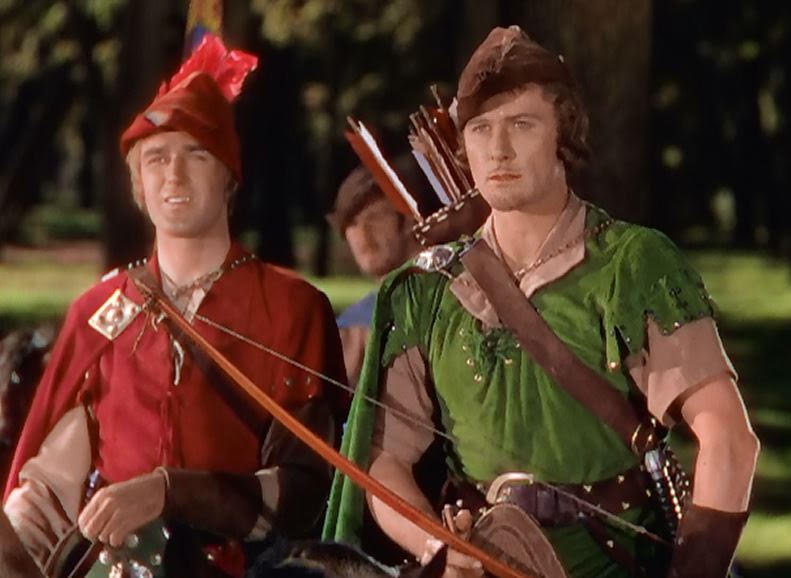
NATHANIEL: Cláudio, I think it wise to start with the Best Picture nominees that year, since that often reflects general favour within the specific branches, too. Take The Adventures of Robin Hood since it begs discussion in all craft areas. The costumes are by Milo Anderson who was working a lot in the 1930s and had already designed for Olivia de Havilland and Erroll Flynn in Captain Blood (1935). I'm just guessing that the very technicolor-ready costumes are wildly ahistorical but they're fun.
I appreciate that so many of Robin's merry band of outlaws are in greens and browns... forest camouflage! But how effective is that camouflage, really, when Robin's own sleeves are adorned with sun catching sequins and his right hand man, Will Scarlett has a giant bright red feather atop his hat. Unless Sherwood Forest was overrun with giant cardinals that cap is asking for trouble: shoot arrows here!
CLÁUDIO: Period costume design in 1930s Hollywood was anachronistic as a rule. The Adventures of Robin Hood doesn't run away from that, presenting quite a ravishing visual spectacle of bright colors and glamourous textiles that make little sense even within the narrative. As you say, that's some glaringly faulty camouflage. It's also amazing that, no matter how many adventurous set pieces there are, Robin and his band of thieves never get their clothes even a little bit rumpled or dirtied up. Their costumes are always pristine and freshly-pressed, straight out of some mysterious laundry hidden within the Sherwood forest.
That's not a dig, by the way. I adore the overt artifice of the film which looks more like a storybook come to life than a reconstruction of 12th century England. That being said, its use of bright colors, especially the reds and blues of the kingly court, does suggest the art of the period. Few live-action movies have ever evoked the pictorial beauty of Medieval illuminations like The Adventures of Robin Hood. It's perhaps because of such qualities that the picture feels so timeless despite its style being so tied to the conventions of 30s Hollywood and the early years of three-strip Technicolor.
It's also interesting to ponder that movie's use of color and the greenery of Robin's garments when the other 1938 costume most associated with a particular hue comes from a black-and-white movie. Curiously enough, the reddest dress of all time appears in shades of grey.
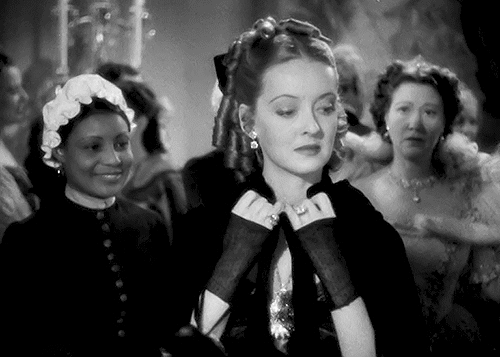
NATHANIEL: Ah Jezebel. Or, rather, Bette Davis as Julie Marsden. It's so crazy how well the red dress reads in Jezebel, both visually and narratively. But black and white costuming was its own artform. Sometimes the colors weren't at all what you'd think in order to give off the right illusions onscreen. I've always longed to see set photos in color from black and white pictures to see how hideous the costumes might have actually looked to the eye rather than the camera in order to look beautiful without color.
I love Jezebel's costume design and not just for that reddest of "red" dresses -- even though that lengthy scene is the best remembered in the picture. I think the movie is especially smart about the costuming, in tandem, of Fay Bainter's Aunt Belle and willful shit-stirrer Julie. They always match in that they've very clearly related in time period and style and wealth (and blood) and yet they're always shown in marked contrast, too. Aunt Belle's dresses are much fussier (as befits her more inhibited spirit) but one detail I find interesting is that when Aunt Belle is showing off her decolettage for example, Julie is buttoned up (and vice versa) and the "color" is always dissimilar.
CLÁUDIO: Supposedly, the red dress was brown in real life as the scarlet fabric didn’t register properly on-camera. Interestingly, another big part of that costume’s impact is how shockingly anachronistic it is. Most of Jezebel’s wardrobe differs greatly from history and pieces like Julie’s virginal white evening gown have much more to do with 1930s tastes than mid-19th century fashions. Even so, they suggest the period and avoid making glaring design choices that call the spectator’s attention to the fakery. All except the red dress whose strapless look leaves no doubts that it’s a costume that doesn’t belong in that setting. It’s historical inaccuracy weaponized to make Julie’s social transgression feel even more seismic.
NATHANIEL: Good point. Speaking of period anachronisms. Sometimes that's fun (as in Robin Hood) and other times it's kind of annoying, frankly.
I recently watched If I Were King, another socialist swashbuckler like Robin Hood, and the costumes were hideous! The proportionizing to borrow a Drag Race term was insanely unbecoming and the armor looked cheap and so on. I think the anachronisms and frugal studio system costuming (i assume they had tons of reuse from other films on the regular) is one reason why the then-contemporary costumes or films that were about showbiz and weren't exactly period or contemporary (like Alexander's Ragtime Band) but more about glamour are often more exciting for our modern eyes.
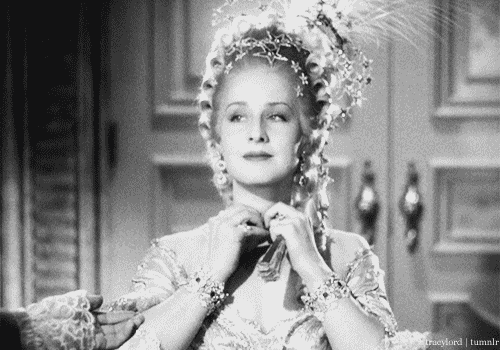
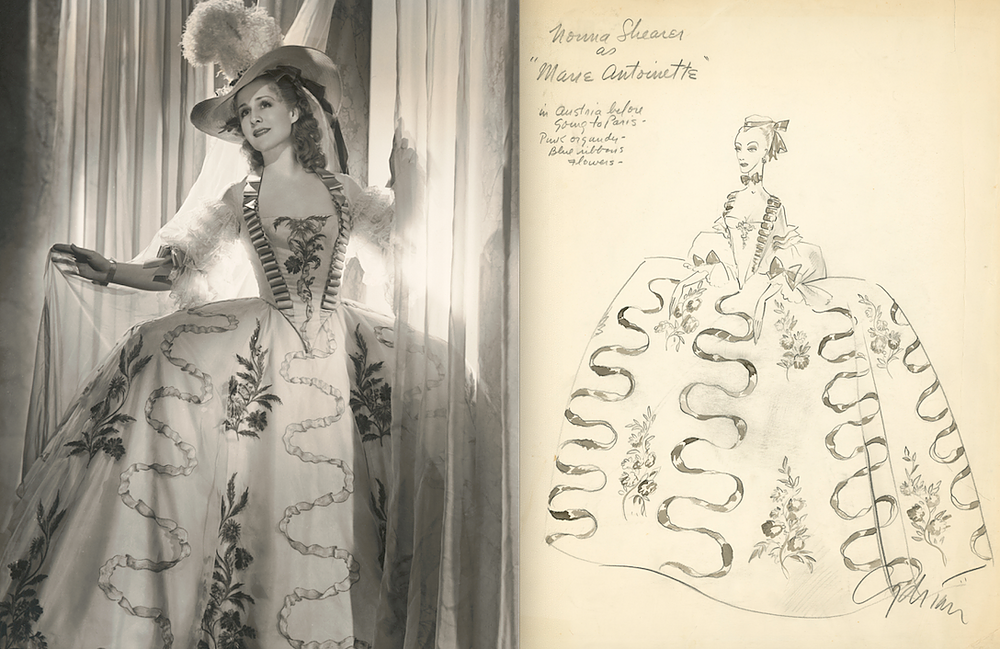
CLÁUDIO: You mention frugal studio costuming and costume recycling which reminds me of MGM’s sumptuous Marie Antoinette. No costs were spared when it came time for Adrian to evoke the Court of Versailles and the studio made sure to get their money’s worth in the years to come. You can see gowns from that Rococo extravaganza in a variety of other MGM titles from the 30s, 40s, 50s, and 60s. The wardrobe of the 18th-century portions of 1943’s DuBarry Was a Lady is practically all made of Marie Antoinette re-wears, while Singin’ in the Rain made great use of the same costumes for its film within a film. Such stars as Joan Crawford, Lucille Ball, Kim Novak, and even Salma Hayek have worn those same dresses that once adorned Norma Shearer and Gladys George.
NATHANIEL: I suppose we should talk about contemporary costuming, as Oscar voters appreciated that particular fine art much more in the first few decades of the category. I'll start by praising Holiday. I don't love Cary Grant's boxy suit but I'm not exactly supposed to... but he sure looks smashing in a tux.
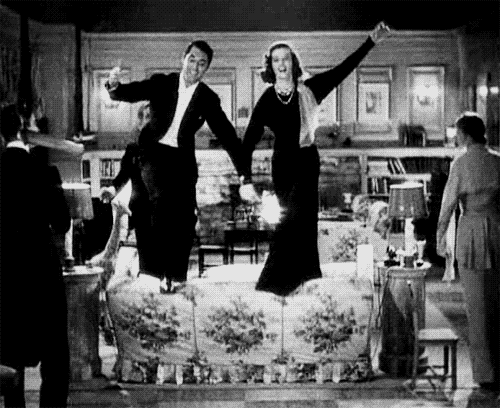
Robert Kalloch, a now forgotten designer, did terrific work in the 1930s and had a great flair for the needs of screwball comedy and movie star beauty simultaneously (he also did It Happened One Night and The Awful Truth). He does a wonderful job with the delineations of wealth in the principal cast. But mostly I love the way he highlights the spiritual differences of Doris Nolan and Katharine Hepburn, without judgment, as the glamorous sisters who feel so differently about that wealth. They both look like a million bucks but Julia (Nolan) is obviously dressing to impress whereas Linda (Hepburn) looks far more minimalist but still completely chic. Do you agree on Holiday and are there other contemporary '38 pictures you find noteworthy for the clothing?
CLÁUDIO: I also love the costumes of Holiday. As you mention, the way it distinguishes different characters' relation to their wealth is quite astounding. Another Katharine Hepburn/Cary Grant flick from 1938 with great costumes is Bringing Up Baby. In that screwball comedy, designer Howard Greer finds exquisite ways of using glamourous garments as tools for humor. There's the obvious example of Hepburn's metallic gown with a matching veil that loses part of its skirt, exposing her undergarments. However, I'm even more impressed by how the floaty fabrics she wears later on the story contribute to her funny clumsiness. Would the pratfalls be as funny if they weren't highlighted by a flurry of chiffon flying across the screen?
Speaking of floating couture, Carefree might be my least favorite of the Fred & Ginger movies but its costumes are to die for. From Rogers' draped silks contorting in slow-motion to a showstopping striped wedding gown, it's all spectacular. My favorite individual design of Howard Greer (again!) is a frock the leading lady wears adorned with a "hearts and arrows" motif harkening back to the screenplay's obsession with psychoanalysis.
Sometimes, of course, the reasons for loving a movie wardrobe are more shallow than cerebral, more visceral than intellectual. I have no elaborate way of justifying my adoration for the fashions of Merrily We Live. It's just beautiful and otherworldly glamourous, an escapist dream for audiences living through The Great Depression, pure glitz that dazzles and entertains while never asking the spectator to ponder on matters of visual storytelling. Considering the picture's nominations for Cinematography and Art Direction, I imagine AMPAS would have added it to a Best Costume Design lineup had the award existed back then.
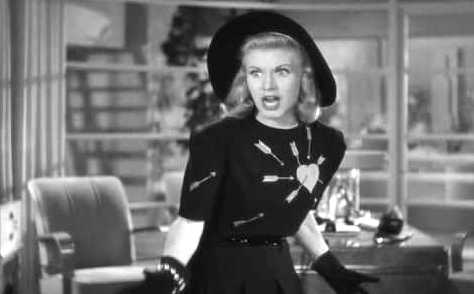 Ginger Rogers in "Carefree"
Ginger Rogers in "Carefree"
NATHANIEL: I think that's a good bet and yes on Carefree's costumes. Ginger Rogers hearts & arrows dress is peak cheekiness for a romantic comedy -- my eyes were solid emoji hearts for that entire sequence of the movie from her costume alone. Well, her game comic timing didn't hurt. Fred & Ginger should really be referred to as 'Ginger & Fred' since she's always acting circles around him as well as that famous adage about their dancing that 'she did everything he did only backwards and in high heels.' She's great in the movie but Christ that movie is sexist. Another sexist costuming moment I love (sorry, it's 1938 -- what can be done?) is that scene in Alexander's Ragtime Band where Tyrone Power starts tearing pieces of Alice Faye's dress off because he thinks she looks like a cheap whore, basically. What's revealed by his aggressive would-be-stylist antics is that she actually looks totally glamorous underneath all the fuss. So he's right even if he's a beast about it.
Care to leave us one more costuming moment you love from '38 before we announce our own ballots and what we think Oscar would have chosen?
CLÁUDIO: While Alexander Nevsky wasn't eligible for the Oscars in 1938, I'd still like to show it some love. The costumes often feel fake, more theatrical than real, but that ends up being a feature than a fault. Sergei Eisenstein's epic looks like a Medieval pageant, History as overt storytelling rather than documented fact, and the costumes are a big part of it. I especially admire the armored pieces, their exaggerated gloom and absurdist details like sculptural helmets and mask-like visors.
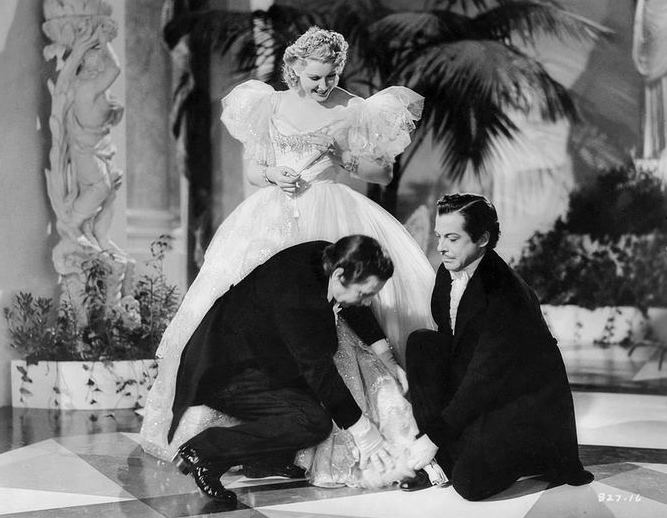 The Great Waltz was one of 11 pictures designed by the legendary Adrian in 1938
The Great Waltz was one of 11 pictures designed by the legendary Adrian in 1938
NATHANIEL: Ooh i have yet to see that one. The further I got into my screenings (I've watched 25 titles from that cinematic year in the past two months) the more I realized I still needed to see. OKAY. Let's reveal our ballots, retro-predictive and personal. Now, in the early days of the costume design they weren't doing five nominees but like two separate categories with only 2 nominees each for black and white versus color. But that would be far too limiting for us (especially since as far as I can tell there were only 5 color movies in '38 as they were still somewhat rare: The Goldwyn Follies, Adventures of Tom Sawyer, Adventures of Robin Hood, Kentucky, and Sweethearts. So let's just do a standard 5 and include all kinds of movies!
I'm going to say Oscar would have gone with:
- Adventures of Robin Hood, Milo Anderson
- The Great Waltz, Adrian
- Jezebel, Orry-Kelly
- Marie Antoinette, Adrian
- Merrily We Live, Irene and Howard Greer
Though part of me wonders if I'm way off as it's also easy to picture any one of three other '38 musicals getting in: Carefree, Sweethearts (also by Adrian... so busy that year), or Alexander's Ragtime Band (Gwen Wakeling); All three received multiple Oscar nominations and are definitely showy.
I'm still thinking about my personal ballot, but it might go...
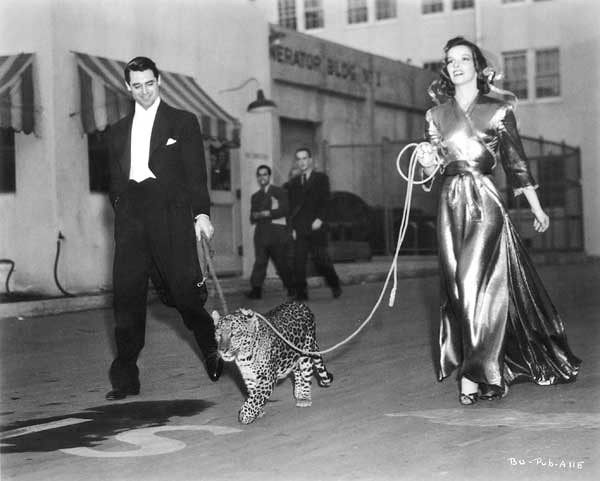 on the lot with "Baby" from Bringing Up Baby
on the lot with "Baby" from Bringing Up Baby
- Bringing Up Baby, Howard Greer
- Grand Illusion, René Decrais
- Holiday, Robert Kalloch
- Jezebel, Orry-Kelly
- Marie Antoinette, Adrian
...but really it's a tough call. I already want to change my answer and the films are still marinating since I so recently watched them! How about you?
CLÁUDIO: It's hard to discern what Oscar voters would have chosen for this not-yet existent category back in 1938. Your predicted five seem very plausible, but my guess is a tiny bit different…
- The Adventures of Robin Hood, Milo Anderson
- Jezebel, Orry-Kelly
- Marie Antoinette, Adrian
- Merrily We Live, Irene and Howard Greer
- Suez, Royer
Maybe I'm being foolish for predicting a lineup without a single musical.
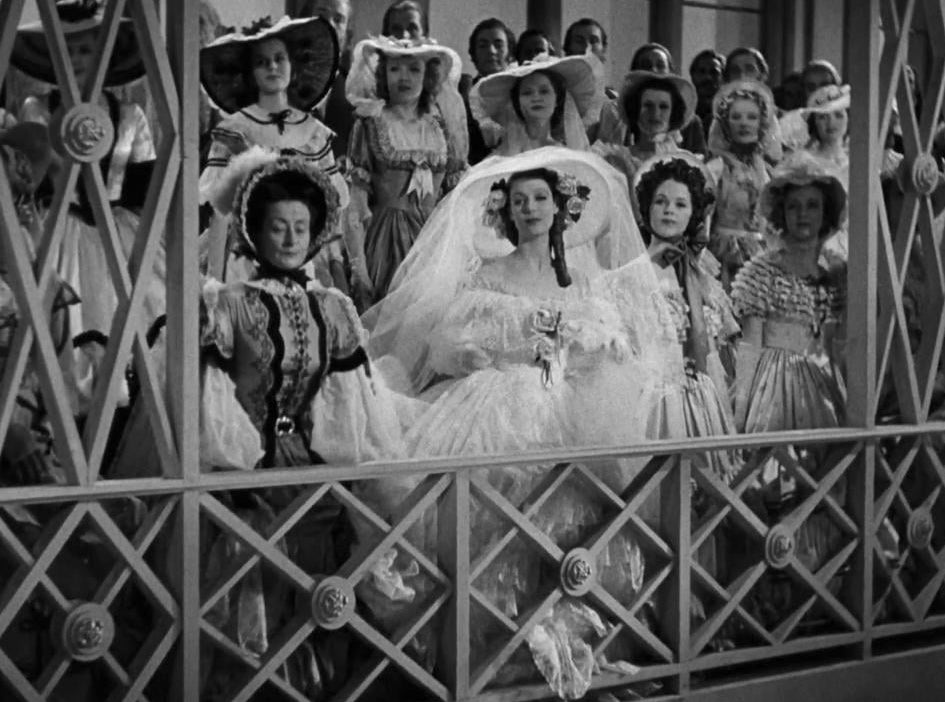 the extravagance of Suez
the extravagance of Suez
It's hard to argue against the four movies we both chose. Robin Hood and Jezebel were beloved by AMPAS and so was Merrily We Live which, despite not getting into Best Picture, did earn more nods than those two classics. As for Marie Antoinette, its opulence is impossible to ignore and MGM wasn't shy about publicizing the spectacle of the movie's Rococo extravagance.
As for Suez, it's the only movie from 1938 which I can think of that even comes close to Marie Antoinette's sheer excess. Royer dressed Loretta Young as Empress Eugenie with no expenses spared, often copying historical portraits and covering the starlet in what looks like miles of ruffled tulle. As an alternative, I'd say Alexander's Ragtime Band would have also been a likely contender since the only movie that got more nominations was You Can't Take It With You.
My ballot would look like this…
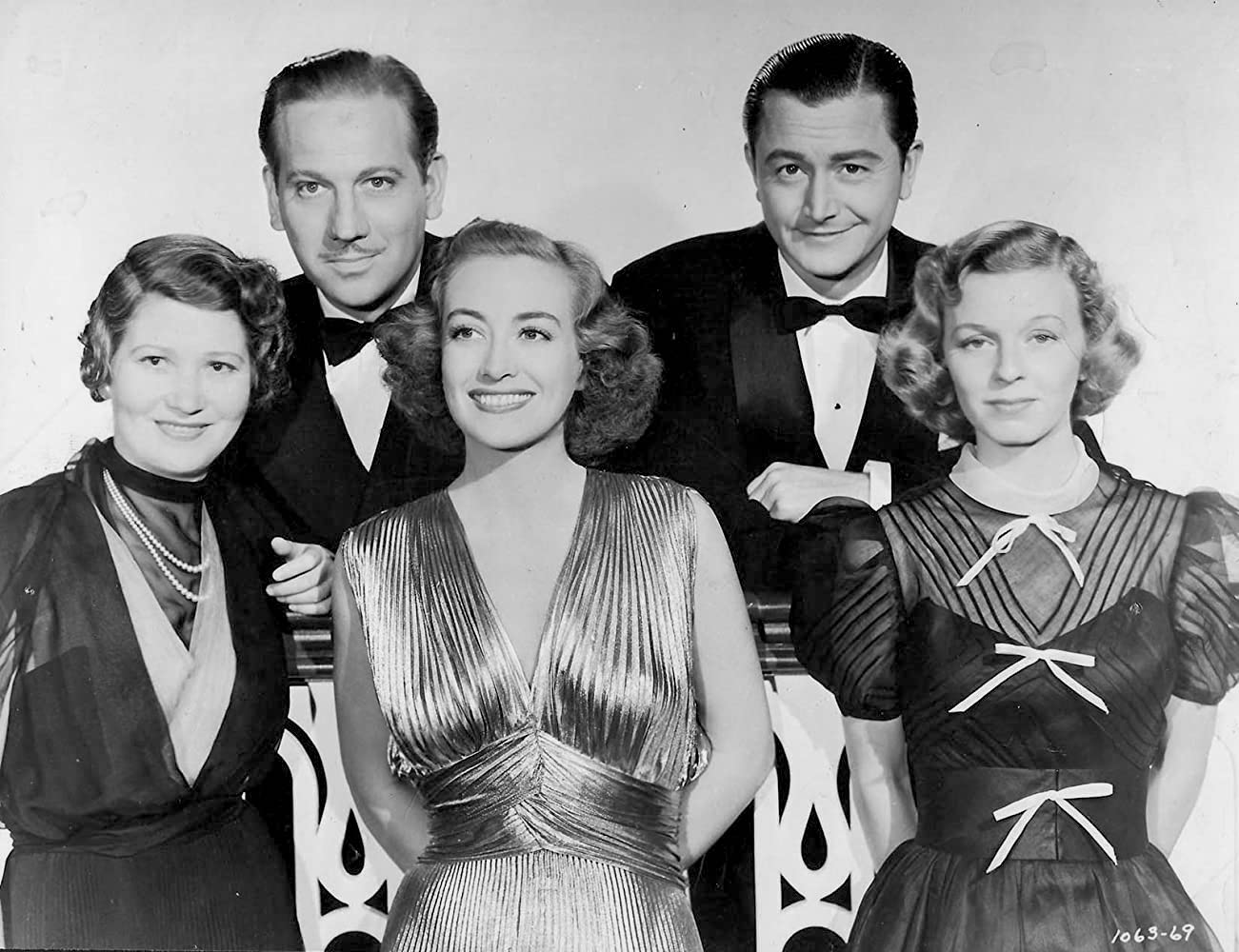 The Shining Hour, another by Adrian
The Shining Hour, another by Adrian
- The Adventures of Robin Hood, Milo Anderson
- Carefree, Howard Greer
- Jezebel, Orry-Kelly
- Marie Antoinette, Adrian
- The Shining Hour, Adrian
I'm just considering Oscar eligible titles or else I'd substitute The Shining Hour's clever character contrasts with the bellicose pageantry of Alexander Nevsky. As for winners, Marie Antoinette gets the gold in my imaginary Oscars.
NATHANIEL: You have brilliant taste as ever and now that you say it Suez does seem very plausible.
Now, dear readers, Cláudio and I would both love to hear about your favourite costumes of 1938. Who do you think would have been nominated and won and do you have a favourite single costume from that year?